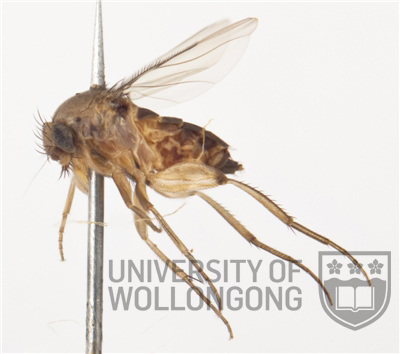Taxonomy
Family: Phoridae
Subfamily: Metopininae
Genus: Megasellia Rondani 1856
Species: scalaris (Leow 1866)
The egg, first-, second- and third-instar larvae and the puparium were described by Liu & Greenberg (1989).
Biology
Megasellia scalaris, also known as the scuttle fly, is a cosmopolitan species that infests a broad spectrum of decaying organic matter. Its larvae can become facultative predators, parasitoids or parasites of other insect larvae, and thus have a reputation as a pest species by those maintaining insect laboratory cultures (Disney 2008). This fly may become an important forensic indicator when a corpses is unable to be accessed by the larger flies, such as calliphorids and sarcophagids. Phorids are notorious for gaining access through the smallest openings (Disney 2008). Thus M. scalaris may be the only insect found infesting a corpse when insect access is severely restricted. See Disney (2008) for a review on the forensic uses of M. scalaris.
Distribution
This species has an almost global distribution, and records only indicate this species being widespread in Australia.
Relevant Literature
Disney, R.H.L. (2008) Natural history of the scuttle
fly, Megaselia
scalaris. Annual
Review of Entomology 53,
39-60.
Greenberg, B. and Wells, J.D. (1998) Forensic use of
Megaselia abdita
and M. scalaris
(Phoridae: Diptera) : case studies,
development rates, and egg structure. Journal of Medical
Entomology 35,
205-209.
